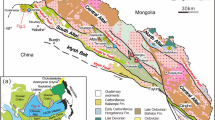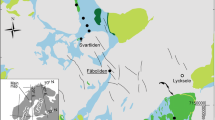Abstract
The Björkdal gold deposit is located in the eastern part of the Early Proterozoic Skellefte district in northern Sweden. The ore zone is hosted by a granitoid which intrudes a 1.9 Ga old supracrustal sequence and consists of a network of quartz veins between two shear zones. The ore mineralogy, alteration assemblages, ore fluid characteristics and general setting of the Björkdal deposit reveal many similarities with mesothermal Archean systems. Three types of fluids are represented by fluid inclusions observed in quartz, scheelite and calcite. The first type consists of a CO2-rich fluid which is syngenetic with the formation of the quartz veins. These inclusions occur in quartz and scheelite. Isotopic equilibrium temperatures derived from quartz-scheelite pairs reflect depositional temperatures around 375 °C. Molar volumes of the carbonic fluid inclusions, ranging down to 55 cm3mole, indicate a maximum lithostatic trapping pressure of 1.8 kbar. These fluids were generated at depth in conjunction with early orogenic magma-forming processes. The gold was introduced to the vein system by the carbonic fluid but the gold was deposited after reactions between this fluid and the wall-rock, producing a slightly alkaline, more CH4-rich aqueous type 2 fluid. Fluid inclusions of this chemically modified fluid indicate that the precipitation of the gold, together with pyrrhotite, pyrite and chalcopyrite, occurred under heterogenous conditions at a temperature of 220 °C and a hydrostatic pressure of 0.5 kbar. The gold deposition occurred from fluids with a δ 18O signature of around +8‰ and δD values close to zero per mil. Any metamorphic influence on the stable isotopic signatures is regarded as minimal. The isotope data suggest rather that a surface-derived fluid component had access to the vein system during this process. At a post-vein forming stage (metamorphic stage ?) a secondary episode of gold mobilization occurred as suggested by the aqueous type 3 inclusions trapped in cross-cutting microfractures in quartz and randomly in calcite, and with homogenization temperatures between 145–220 °C and a salinity up to 11eq. wt.% NaCl.
The Skellefte district is a major ore province, which forms a 200 by 50 km area in northern Sweden (Fig. 1), comprising numerous stratabound massive sulfide ore deposits. During the last decade epigenetic gold deposits have received increasing interest from a prospecting point of view. The Björkdal deposit is one of several epigenetic gold discoveries made recently in the Skellefte district. In 1985 a geochemical survey, designed on a grid-pattern basis, revealed a gold anomaly about 12 km north-east of the Boliden community and three years later the Björkdal gold mine was in operation. The annual production is about 960 000 metric tons of ore (1992) and the total reserves are estimated at a minimum of 7 Mton of ore with a gold grade of 2.9 ppm. This paper reports on the geological features of the Björkdal deposit and discusses the genesis of the deposit on basis of fluid inclusions and distribution of oxygen and hydrogen isotopes.
Similar content being viewed by others
References
Berger, B.R., Henley, R.W. (1989) Advances in the understanding of epithermal gold-silver deposits, with special reference to the western United States. In: The geology of gold deposits: the perspective in 1988, Econ. Geol. Monogr. 6:405–423
Billström, K., Grensman, F. (1993) Source and timing of gold deposition in volcanic and intrusive settings in the Skellefte district, northern Sweden (abstract). In: Hach-Ali, P.F., Torres-Ruiz, J., Gervilla, F. (eds.) Current research in geology applied to ore deposits. University of Granada, Spain, pp. 407–410
Billström, K., Vivallo, W. (1994) Synvolcanic mixing of ore Pb and the development of lead isotopic provinces in the Skellefte district, Sweden. Mineral. Deposita 29:111–119
Bowers, T.S., Helgeson, H.C. (1983) Calculation of the thermodynamic and geochemical consequences of nonideal mixing in the system H2O-CO2-NaCl on phase relations in geologic systems: equation of state for H2O-CO2-NaCl fluids at high pressures and temperatures. Geochimica Cosmochimica Acta 47:1247–1275
Broman, C. (1987) Fluid inclusions of the massive sulfide deposits in the Skellefte district, Sweden. Chemical Geology 61:161–168
Broman, C. (1988) Fluids associated with the genesis of the Skellefte district massive sulfide deposits, Sweden. In:Zachrisson, E. (ed.) Proceedings of the Seventh Quadrennial IAGOD Symposium. Schweizerbart'sche Verlagsbuchhandlung, Stuttgart, pp. 191–200
Burke, E.A.J., Lustenhouwer, W.J. (1987) The application of multichannel laser Raman microprobe (Microdil-28) to the analyses of fluid inclusions. Chemical Geology 61:11–17
Claesson, S., Huhma, H., Kinny, P.D., Williams, I.S. (1993) Svecofennian detrital zircon ages-implications for the Precambrian evolution of the Baltic shield. Precambrian Res. 64:109–131
Claesson, S., Lundqvist, T. (1990) Svecofennian granites in the Bothnian basin, central Sweden. Abstract from the 19th Nordic geological Wintermeeting, Stavanger, Norway. Geonytt. 17:36
Colvine, A.C., Andrews, A.J., Cherry, M.E., Durocher, M.E., Fyon, A.J., Lavigne, M.J., Jr., McDonald, A.J., Marmont, S., Poulsen, K.H., Springer, J.S., Troop, D.G. (1984) An integrated model for the origin of Archean lode gold deposits. Ontario Geol. Survey Open-File Rept. 5524: 98p
Craw, D., Koons, P.O. (1989) Tectonically induced hydrothermal activity and gold mineralization adjacent to major fault zones. In: The geology of gold deposits: the perspective in 1988. Econ. Geol. Monogr. 6:471–478
Crawford, M.L. (1981) Fluid inclusions in metamorphic rocks low and medium grade. In: Hollister, L.S., Crawford, M.L. (eds.) Short Course Handbook. Min. Assoc. Can. 6: 157–181
Diamond, L.W. (1992) Stability of CO2 clathrate +CO2 vapour + aqueous KCl-NaCl solutions: experimental determination and application to salinity estimates of fluid inclusions. Geochimica Cosmochimica Acta 56:273–280
Dowling, K., Morrison, G. (1989) Application of quartz textures to the classification of gold deposits using North Queensland examples. In: The geology of gold deposits: the perspective in 1988. Econ. Geol. Monogr. 6:342–355
Fallick, A.E., Jocelyn, J., Hamilton, P.J. (1987) Oxygen and hydrogen stable isotope systematics in Brazilian agates. In: Rodriques-Clemente, R. Tardy, Y. (eds.) Geochemistry and mineral formation in the earth surface. CSIC Madrid and CNRS Paris:99–117
Golding, S.D., McNaughton, N.J., Barley, M.E., Groves, D.I., Ho, S.E., Rock, N.M.S., Landis, G.P. (1989) Archean carbon and oxygen reservoirs. Their significance for fluid sources and circulation paths for Archean mesothermal gold deposits of the Norseman-Wiluna belt, western Australia. In: The geology of gold deposits: the perspective in 1988. Econ. Geol. Monogr. 6:376–388
Gripm, E., Wirstam, Å. (1970) The Boliden sulphide deposit. Sveriges Geologiska Undersökning Ser. C, 651: 72p
Heyen, G., Ramboz, C., Dubessy, J. (1982) Simulation des équilibres de phases dans le système CO2-CH4 en dessous de 50 °C et de 100 bar. Application aux inclusions fluides. C.R. Acad. Sc. Paris. 294, II:203–206
Javoy, M. (1977) Stable isotopes and geothermometry. J. Geol. Soc. London. 133:609–636
Kerkhof, A.M., van den (1988) The system CO-CH4-N2 in fluid inclusions: theoretical modelling and geological applications. Ph.D. Thesis, Free University Press, Amsterdam, 206p
Lundberg, B. (1980) Aspects of the geology of the Skellefte field, northern Sweden. Geologiska Föreingens i Stockholm Förhandlingar. 102:155–166
Markkula, H. (1989) Malmgenes i Vindelgransele-området SV Skelleftefältet (in Swedish). PRAP 89077: 42p
Matsuhisa, Y., Goldsmith, J.R., Clayton, R.N. (1979) Oxygen isotope fractionation in the system quartz-albite-anorthite-water. Geochimica Cosmochimica Acta. 43:1131–1140
Nicolson, D., Rickard, D., Jonsson, R. (1988) Au distribution in volcanogenic massive sulphide ores, Skellefte Field, N. Sweden (abstract). In: Bicentennial Gold 1988. 1:161–164
Nysten, P. (1990) Tsumoite from the Björkdal gold deposit, Västerbotten County, northern Sweden, Geologiska Föreningens i Stockholm Förhandlingar. 112:59–60
Potter, R.W., II, Clynne, M.A., Brown, D.L. (1978) Freezing point depression of aqueous sodium chloride solutions. Econ. Geol. 73:284–285
Poty, B., Leroy, J., Jachimowisz, L. (1976) Un nouvel appareil pour la measure des temperatures sous le microscope: l'installation de microthermometric Chaixmeca. Bull. Soc. Francaise Min. Crist. 99:182–186
Rickard, D.T. (1986) The Skellefte field, Sveriges Geologiska Undersökning, Ser. Ca 62:1–54
Rickard, D., Nicolson, D., Rogers, G., Park, P., Swainbank, I. (1991) Source of gold in a volcanogenic massive sulphide deposit (abstract). In:Pagel, M. Leroy, J.L. (eds.). Source, transport and deposition of metals. Balkema, Rotterdam, pp. 333–336
Rickard, D.T., Zweifel, H. (1975) Genesis of Precambrian sulfide ores, Skellefte district, Sweden. Econ. Geol. 70:255–274
Seitz, J.C., Pasteris, J.D., Wopenka, B. (1987) Characterization of CO2-CH4-H2O fluid inclusions by microthermometry and laser Raman microprobe spectroscopy: inferences for clathrate and fluid equilibria. Geochimica Cosmochimica Acta 51:1651–1664
Seward, T.M. (1973) Thio complexes of gold and the transport of gold in hydrothermal ore solutions. Geochimica Cosmochimica Acta. 37:379–399
Seward, T.M. (1989) The hydrothermal chemistry of gold and its implications for ore formation: Boiling and conductive cooling as examples. In: The geology of gold deposits: the perspective in 1988. Econ. Geol. Monogr. 6:398–404
Shieh, Y-N, Zhang, Guo-Xin (1991) Stable isotope studies of quartzvein type tungsten deposits in Dajishan Mine, Jiangxi Province, Southeast China. In: Taylor, H. P., Jr., O'Neil, J.R., Kaplan, I.R. (eds.) Stable isotope geochemistry: a tribute to Samuel Epstein. The Geochemical Society, Spec. Publ. No. 3: 425–435
Sillitoe, R.H. (1989) Gold deposits in western Pacific island arc: the magmatic connection. In: The geology of gold deposits: the perspective in 1988. Econ. Geol. Monogr. 6:274–291
Skiöld, T. (1988) Implications of new U-Pb zircon chronology to early Proterozoic crustal accretion in northern Sweden. Precambrian Res. 35:161–167
Sundblad, K., Weihed, P., Billström, K., Markkula, H., Mäkelä, M. (1993) Source of metals and age constraints for epigenetic gold deposits in the Skellefte and Pohjanmaa districts, central part of the Fennoscandian Shield. Mineral. Deposita 28:181–190
Suzuoki, T., Epstein, S. (1976) Hydrogen isotope fractionation between OH-bearing minerals and water. Geochimica Cosmochimica Acta 40:1229–1240
Taylor, H.P. (1979) Oxygen and hydrogen isotope relations in hydrothermal ore deposits. In:Barnes, H.L. (ed.) Geochemistry of hydrothermal ore deposits, 2nd ed. Wiley, New York, pp 236–277
Weihed, P., Bergman, J., Bergström, U. (1992) Metallogeny and tectonic evolution of early Proterozoic Skellefte district, northern Sweden. Precambrian Res. 58:143–167
Weihed, P. Fallick, A.E. (1994) A stable isotope study of the Proterozoic Tallberg porphyry-type deposit, northern Sweden. Mineral. Deposita 29:128–138
Weihed, P., Schöberg, H. (1991) Age of porphyry-type deposits in the Skellefte district, northern Sweden. Geologiska Föreningens i Stockholm Förhandlingar. 113:289–294
Wesolowski, D., Ohmoto, H. (1986) Calculated oxygen isotope fractionation factors between water and the minerals scheelite and powellite. Econ. Geol. 81:471–477
Wilson, M.R., Sehlstedt, S., Claesson, L-Å., Aftalion, M., Hamilton, P.J., Fallick, A.E. (1987) Jörn, an early Proterozoic intrusive complex in a volcanic-arc environment, north Sweden. Precambrian Res. 36:201–225
Vivallo, W. (1987) Early Proterozoic bimodal volcanism, hydrothermal activity, and massive sulfide deposition in the Boliden-Långdal area, Skellefte district, Sweden. Econ. Geol. 82:440–456
Vivallo, W., Claesson, L-Å. (1987) Intra-arc rifting and massive sulfide mineralization in an early Proterozoic volcanic arc, Skellefte district, northern Sweden. Geol. Soc. London Spec. Publ. 33:69–79
Author information
Authors and Affiliations
Rights and permissions
About this article
Cite this article
Broman, C., Billström, K., Gustavsson, K. et al. Fluid inclusions, stable isotopes and gold deposition at Björkdal, northern Sweden. Mineral. Deposita 29, 139–149 (1994). https://doi.org/10.1007/BF00191511
Received:
Accepted:
Issue Date:
DOI: https://doi.org/10.1007/BF00191511




